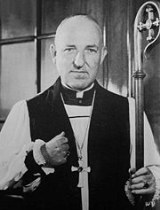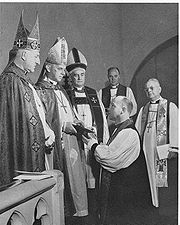
Albert R. Stuart
Encyclopedia
Albert Rhett Stuart was born in 1905 in Washington. He was the Sixth Bishop of Georgia
. He was the 532nd
bishop
of the Episcopal Church in the United States of America (ECUSA).
on October 20, 1954 in St. Pauls, Augusta
. He had been elected during the diocesan convention of 1954 when seventeen persons were nominated to succeed Bishop Barnwell
. Even with the large field of candidates, Stuart was elected on the second ballot. He was then serving as the Dean of Christ Church Cathedral, New Orleans, and had previously served as rector of the Church of the Redeemer in Greenwood, South Carolina and as rector of St. Michael's, Charleston.
Eighteen months after becoming the diocesan bishop, Stuart told the convention meeting May 8–9, 1956 at St. Thomas' Episcopal Church in Thomasville,
 Henry Louttit, recalls in his booklet, Saints of the Diocese of Georgia how Bishop Stuart was often the only white voice for integration in Savannah willing to speak on TV. He remembers him speaking up for integration on a visit to Trinity Episcopal Church in Stateboro saying,
Henry Louttit, recalls in his booklet, Saints of the Diocese of Georgia how Bishop Stuart was often the only white voice for integration in Savannah willing to speak on TV. He remembers him speaking up for integration on a visit to Trinity Episcopal Church in Stateboro saying,
In 1957, Stuart dedicated a newly acquired Diocesan House on East Bay Street in Savannah as the diocesan headquarters. At that time, there were 9,976 communicants in the Episcopal Diocese of Georgia.
He served as diocesan bishop through 1971. He died two years later and was buried on Holy Saturday of that year, April 21, 1973.
Georgia (U.S. state)
Georgia is a state located in the southeastern United States. It was established in 1732, the last of the original Thirteen Colonies. The state is named after King George II of Great Britain. Georgia was the fourth state to ratify the United States Constitution, on January 2, 1788...
. He was the 532nd
Succession of Bishops of the Episcopal Church in the United States
This list consists of the bishops in the Episcopal Church in the United States of America, an independent province of the Anglican Communion. This shows the historic succession of the episcopate within this denomination.-Key to chart:...
bishop
Bishop
A bishop is an ordained or consecrated member of the Christian clergy who is generally entrusted with a position of authority and oversight. Within the Catholic Church, Eastern Orthodox, Oriental Orthodox Churches, in the Assyrian Church of the East, in the Independent Catholic Churches, and in the...
of the Episcopal Church in the United States of America (ECUSA).
Episcopacy
Albert Rhett Stuart was consecrated as the sixth bishop of the Episcopal Diocese of GeorgiaEpiscopal Diocese of Georgia
The Episcopal Diocese of Georgia, USA is one of 20 dioceses that comprise Province IV of the US Episcopal Church, and is a diocese within the worldwide Anglican Communion. The current bishop is the Rt. Rev. Scott Anson Benhase who succeeded the Rt. Rev. Henry I. Louttit, Jr...
on October 20, 1954 in St. Pauls, Augusta
St. Paul's Episcopal Church (Augusta, Georgia)
Saint Paul's Church is a historic Episcopal church located in downtown Augusta, Georgia, adjacent to Riverwalk Augusta.-History:The church was established in 1750 by the Church of England at the site of Fort Augusta. The church, located on the corner of 6th and Reynolds Street, is the oldest church...
. He had been elected during the diocesan convention of 1954 when seventeen persons were nominated to succeed Bishop Barnwell
Middleton S. Barnwell
Middleton Stuart Barnwell was the seventh Bishop of the Episcopal Diocese of Idaho and the fifth Bishop of the Episcopal Diocese of Georgia. Barnwell was the 349th bishop of the Episcopal Church in the United States of America. He was also the first president of what is now Boise State...
. Even with the large field of candidates, Stuart was elected on the second ballot. He was then serving as the Dean of Christ Church Cathedral, New Orleans, and had previously served as rector of the Church of the Redeemer in Greenwood, South Carolina and as rector of St. Michael's, Charleston.
Eighteen months after becoming the diocesan bishop, Stuart told the convention meeting May 8–9, 1956 at St. Thomas' Episcopal Church in Thomasville,
People are discovering that a life full of gadgets is no satisfactory substitute for a life lived in the power and presence of God.He went on to tell that Diocesan Convention that there were six steps needed for the Diocese to "fulfill her responsibility in this generation and improve her evangelstic witness." He named these as:
- A renewal of confidence and conviction that it is the mission of the Church "to proclaim her Lord as the Way, the Truth, and the Life for all Mankind." For this he recommended year round use of Church Schools.
- The diocese should appreciate the magnitude of her present opportunity. He encouraged direct evangelistic effort saying, "It is high time the Episcopal Church rose from her dignified posture of waiting to be discovered...and went out into the byways and hedges seeking souls for whom her Lord died."
- New congregations should be established in areas where the Church had no work and in newly developing urban communities.
- Accelerated support for the Church's University of the South at Sewanee.
- Consideration of the sanctity of the Christian marriage partnership as a basic factor in the problem of human relationships.
- Finally, he expressed concern over the racial problem, urging Churchmen to be vigilant "lest the fear and prejudice surrounding us infiltrate our thinking and confuse us as to our clear duty." He reminded those gathered of the many years in which white and colored Churchmen had "known their unity in Christ and have labored together in one fold under one shepherd."

This is a free country. You can belong to any kind of church you wish, but the Episcopal Church has never asked anyone why they were coming to the church. We are not starting asking people now. This church is open to anyone who wishes to worship.He also told a Diocesan Convention that,
The solution of the problem of our society lies not in the realm of law but in the realm of faith and grace.
In 1957, Stuart dedicated a newly acquired Diocesan House on East Bay Street in Savannah as the diocesan headquarters. At that time, there were 9,976 communicants in the Episcopal Diocese of Georgia.
He served as diocesan bishop through 1971. He died two years later and was buried on Holy Saturday of that year, April 21, 1973.
Sources
- The Episcopal Church in Georgia 1733-1957, by Henry Thompson Malone published by The Protestant Episcopal Church in the Diocese of Atlanta, 1960

